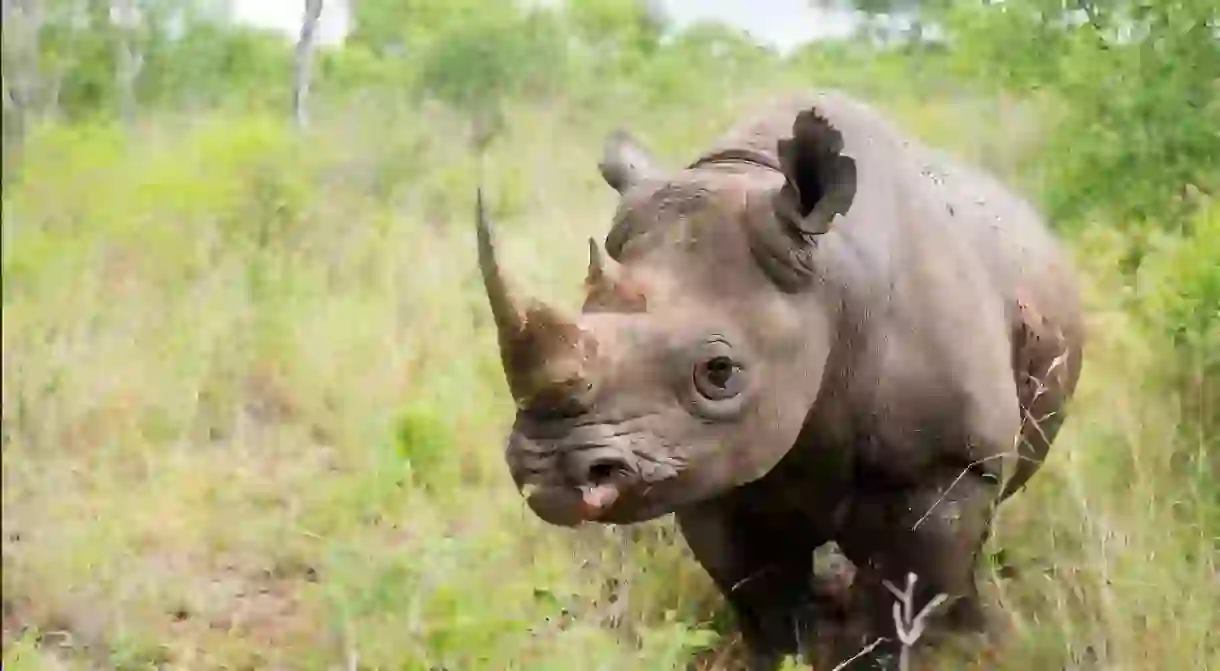How eSwatini is Leading the Way in Rhino Conservation

When it comes to going on safari, your first thought probably isn’t the tiny country formerly known as Swaziland, which is so small the whole country could fit inside South Africa’s Kruger National Park. When it comes to rhino encounters, however, eSwatini proves size isn’t everything.
eSwatini is renowned for its strict rhino conservation laws. There are no official stats on the exact number of rhinos in the country, which protects them from poachers. Reported instances of poaching are much lower than many other African countries, according to Africa Geographic.
Rhino conservation at Mkhaya
eSwatini’s Mkhaya Game Reserve has been central to the country’s wildlife conservation. In 1979 it was acquired by Big Game Parks with the aim of protecting the last of the country’s indigenous Nguni cattle. From then, the park expanded its vision to protecting other threatened and endangered species. The protected area is proud of its stringent conservation security and is home to one of the best anti-poaching units in Africa. As a result of its high security and proactive efforts to protect endangered species, Mkhaya is said to be one of the best places in Africa to see both black and white rhinos – both from game vehicles and on foot.
In response to hunters decimating the country’s wildlife in the 1960s, eSwatini began importing large mammals – such as lions, elephants and rhinos – into the country. They now have several protected wildlife parks as well as stringent legislation against poaching. Anyone caught trying to poach a protected species will be sentenced to a lengthy jail sentence (a minimum of five years) and you can’t pay a fine to get out of the jail time, which is possible in South Africa. You’ll also have to pay back the value of the animal to its owner, and if you can’t afford it, you’ll spend several more years in prison. Rewards are offered for information that leads to the arrest of any poachers, and rangers – who can carry weapons – are allowed to perform a search without a warrant if they suspect poaching activity.

How to spot the difference between black and white rhinos
Both black (Diceros bicornis) and white (Ceratotherium simum) rhinos can be found in eSwatini’s national parks and will often both be found in the same reserve. So, if you see a rhino on your safari, how can you tell if it’s a black or white rhino, especially as there’s no actual colour difference between the two?
Firstly, black rhinos are smaller, weighing between 900 and 1,350 kilos compared to the average 1,800 to 2,000 kilos of an adult male white rhino. Black rhinos are ‘browsers’, eating leaves from trees and bushes, whereas white rhinos are ‘grazers’ and eat grass. This is the reason for the most notable difference between the two animals: black rhinos have a hooked upper lip, which helps them feed on leaves, whereas the white rhino’s lip is broad and square. White rhinos have a larger head because they need lots of muscle in their neck to support it while it’s lowered to the ground for many hours a day, and they have a distinct hump on their neck.
They also have different temperaments, with black rhinos being more timid and aggressive than the notoriously docile white rhino. So, while they are harder to spot, if you do see a black rhino in the wild, it might be a nerve-wracking affair! White rhinos tend to be more easily approachable so you might be able to get closer to them on a walking safari.

Under threat
Rhinos are under threat from poaching and black market trafficking of their horns, particularly for use in traditional Chinese medicine. With between 19,600 and 21,000 white rhinos left in the wild, they are the only species of rhino that is not endangered, but they are listed as ‘near threatened’. In 1995, numbers of black rhinos dropped to just 2,500, the lowest on record. However, although they are still a critically endangered species, conservation efforts are slowly bringing them back from the brink of extinction. Numbers have doubled over the last two decades and today there are between 5,040 and 5,458 black rhinos in the wild.














